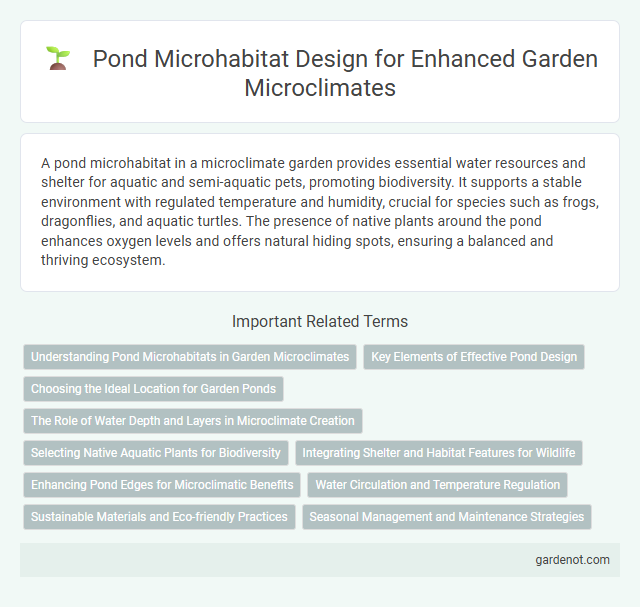A pond microhabitat in a microclimate garden provides essential water resources and shelter for aquatic and semi-aquatic pets, promoting biodiversity. It supports a stable environment with regulated temperature and humidity, crucial for species such as frogs, dragonflies, and aquatic turtles. The presence of native plants around the pond enhances oxygen levels and offers natural hiding spots, ensuring a balanced and thriving ecosystem.
Understanding Pond Microhabitats in Garden Microclimates
Pond microhabitats within garden microclimates create distinct environmental conditions that support diverse aquatic and semi-aquatic species. These microhabitats regulate temperature, humidity, and light exposure, fostering unique ecosystems that enhance garden biodiversity. Understanding the interaction between water chemistry, substrate, and surrounding vegetation is essential for maintaining pond health and promoting sustainable microclimate balance.
Key Elements of Effective Pond Design
Key elements of effective pond design in a microclimate garden include proper depth variation to support diverse aquatic species and maintain temperature stability, strategic placement of native plants for oxygenation and shading, and the incorporation of natural filtration systems such as gravel beds and biofilters to ensure water quality. The integration of rock features and submerged logs creates microhabitats for amphibians and invertebrates, enhancing biodiversity. Efficient drainage and overflow management prevent flooding and water stagnation, maintaining a healthy pond ecosystem.
Choosing the Ideal Location for Garden Ponds
Selecting the ideal location for a garden pond involves assessing sunlight exposure, ensuring at least 4-6 hours of direct sunlight to support aquatic plants and maintain balanced temperatures. Proximity to natural water sources or existing microhabitats can enhance biodiversity and provide a stable microclimate for pond life. Avoiding areas near large trees prevents excessive leaf litter, which can increase organic debris and disrupt water quality.
The Role of Water Depth and Layers in Microclimate Creation
Water depth and stratification in a pond microhabitat significantly influence the microclimate by regulating temperature gradients and oxygen levels. Deeper water layers provide thermal insulation, stabilizing the environment for aquatic organisms while promoting nutrient cycling. Variations in water depth create distinct microclimatic zones that support diverse plant and animal species adapted to specific temperature and light conditions.
Selecting Native Aquatic Plants for Biodiversity
Selecting native aquatic plants for pond microhabitats enhances biodiversity by supporting local wildlife and stabilizing water quality. Species like water lilies, cattails, and pickerelweed provide essential shelter and food sources for amphibians, insects, and birds. Integrating diverse native flora promotes ecological balance and resilience in garden microclimates.
Integrating Shelter and Habitat Features for Wildlife
Pond microhabitats create essential shelter and breeding grounds for diverse wildlife such as amphibians, dragonflies, and waterfowl by incorporating submerged logs, dense aquatic plants, and shallow shorelines. These features enhance biodiversity by providing protection from predators and harsh weather while supporting food sources and nesting sites. Integrating varied vegetation zones around the pond optimizes habitat complexity and encourages species-rich ecosystems within microclimate gardens.
Enhancing Pond Edges for Microclimatic Benefits
Enhancing pond edges with native aquatic plants and natural materials creates a stable microclimate that supports diverse flora and fauna. Strategic placement of rocks and vegetation around the pond helps regulate temperature fluctuations, improving water quality and providing shelter for beneficial insects and amphibians. These modifications promote humidity retention and reduce erosion, fostering a balanced ecosystem within the microhabitat.
Water Circulation and Temperature Regulation
Water circulation in a pond microhabitat enhances oxygen distribution and nutrient cycling, supporting diverse aquatic life. Temperature regulation is influenced by water movement, which prevents stagnation and mitigates temperature extremes, promoting a stable environment. These dynamics create optimal conditions for microorganisms, plants, and animals, maintaining ecological balance in the microclimate garden.
Sustainable Materials and Eco-friendly Practices
Pond microhabitats benefit from sustainable materials such as reclaimed wood, natural stone, and biodegradable liners that enhance water retention and biodiversity while minimizing ecological impact. Incorporating native aquatic plants and organic filtration systems supports water quality and creates a balanced ecosystem. Eco-friendly practices like rainwater harvesting for pond replenishment and avoiding chemical fertilizers reduce pollution and promote long-term habitat sustainability.
Seasonal Management and Maintenance Strategies
Effective seasonal management of pond microhabitats involves regular removal of fallen leaves and debris during autumn to prevent nutrient overload and algae blooms. In spring, monitoring water temperature and oxygen levels supports healthy aquatic plant growth and amphibian breeding cycles. Winter strategies include maintaining open water areas under ice using aerators to sustain aquatic life and prevent stagnation.
Pond microhabitat Infographic

 gardenot.com
gardenot.com